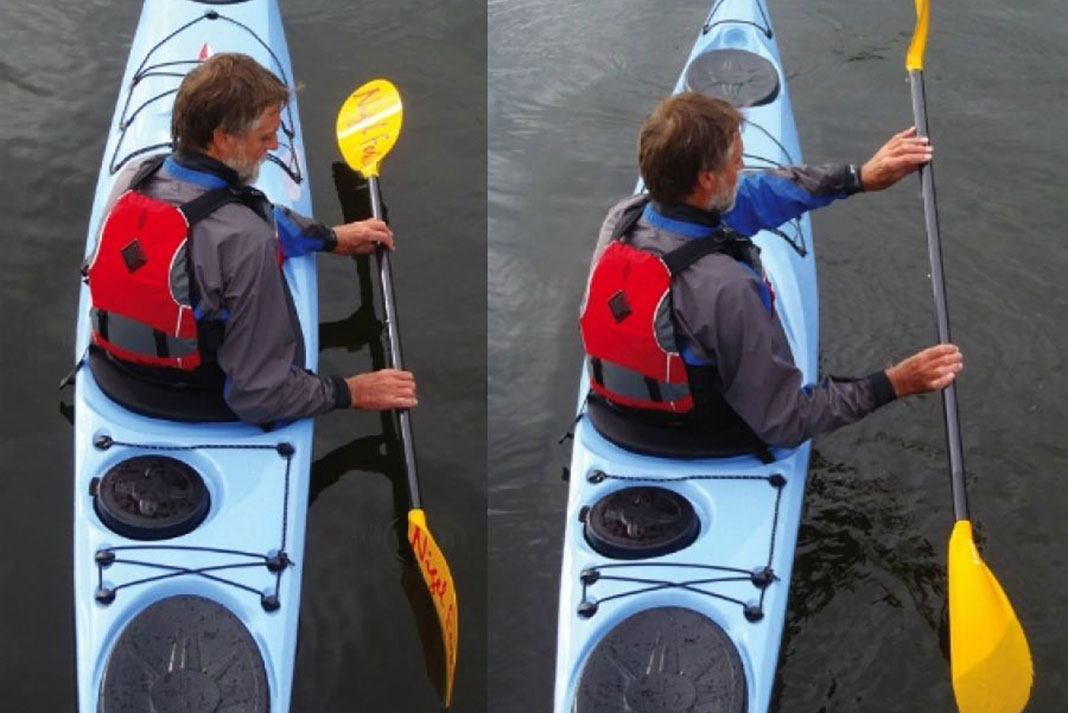If you’ve ever experienced weathercocking in your kayak, you’ll value an efficient way to counter it. The stern draw accomplishes this with very little effort or loss of speed, helping your kayak to maintain a straight line with or across the wind.
What is the kayak stern draw technique?
The stern draw is one type of stern rudder: the blade position pulls the stern sideways rather than pushing it sideways or tracking it straight. The blade is held high, as in a draw stroke, rather than low, as in a sweep stroke. The maneuver relies on water flowing across a static blade face.
Used on the windward side to correct weathercocking, the stern draw is stable and the stern will not skid out. However, attempted on the downwind side, or with no wind, current or waves to counteract it, a good stern draw will initiate a tail skid. This is not its purpose: the stern will overrun the paddle, which could flip you. For this reason, first practice at a slower speed without edging on a windless day. Should your tail skid, keep balance by transitioning into a low brace.
Next, pick a target ahead across the wind so you can monitor the effect of each of the following steps. With forward speed, you’ll likely turn into the wind from your target—the stern draw steers you back.
6 steps to complete the kayak stern draw
1. Position yourself
Rotate torso toward wind/draw side. Hold paddle low, parallel to both water and kayak, both hands above water. Tuck rearmost elbow to hip.

2. Start your stroke
Slice rear blade into water. Blade should remain neutral with water flowing evenly along both sides.
3. Hold and extend the paddle
Hold bottom arm and hand position, raise front arm to shoulder height and with this high hand, push paddle further from kayak. Ideally, straighten top arm at elbow and bring perpendicular to kayak—this depends on your flexibility. This action changes the blade alignment, bringing light pressure against the face. Your kayak should start to turn away from the paddle and the wind. Check against your target.
4. Accentuate the turn
Press with draw-side foot and edge kayak down toward the active blade to release stern and accentuate turn. This also aids top arm extension.
5. Adjust your pressure
Adjust the amount of pressure against blade by raising or lowering your top hand. Remember, you must push away with your top hand. As you become more proficient, use your bottom hand to fine-tune blade angle.
Note: A stern draw placed too far forward becomes a sideslip. If your kayak moves sideways toward the blade without turning, move the blade back.
Next steps to practice with the kayak stern draw
Practice transitioning into the stern draw from a forward stroke. Finishing your forward stroke, slice blade diagonally back from the side of the kayak. Pull your lower arm elbow to your hip and push top arm into its stern draw position.
A sea kayak pioneer, Nigel Foster is an author, boat designer and BCU Level 5 Coach based in St. Petersburg, Florida, where he is a partner and Director of Training at Sweetwater Kayaks.
Peer review of Nigel Foster’s kayak stern draw technique
“As Nigel indicates, the stern draw is a subtle stroke. Too much push with the top hand or edge with the windward hull can cause the kayak to turn downwind, resulting in a drunken series of S turns.”
— Michael Pardy, Paddle Canada level 3 instructor trainer, Victoria, BC
“Use your bottom hand like you would on the throttle of a motorcycle, rolling it forwards or backwards in order to transition between neutral, a pushing sensation and a pulling sensation. By doing this you will be experimenting with both the stern draw and the stern pry. Blade angle is one way of compensating for reduced torso rotation due to lower flexibility.”
— Meaghan Hennessy, Paddle Canada level 2 instructor trainer and BCU level 3 coach, Vancouver, BC
“We learned this great technique from Nigel about 15 years ago. Having this skill has allowed us to paddle kayaks without using skegs ever since.”
— Shawna Franklin and Leon Sommé, BCU level 4 coaches, Orcas Island, WA
“As handy as the stern draw is for correcting weathercocking, it is also delightfully useful when surfing, especially on gently rounded swells or small waves. Apply it at the end of a forward stroke/sweep at the first hint that the kayak wants to broach.”
— Ginni Callahan, ACA level 5 instructor and BCU level 4 coach, Cathlamet, WA / Loreto, Baja
“Remember to always look at your target. As Nigel says, this may be hard if you are not flexible, but it is key to knowing if the draw is working.”
— Christopher Lockyer, Paddle Canada level 4 instructor and BCU level 4 coach, Halifax, NS
This article was first published in the Fall 2012 issue of Adventure Kayak Magazine. Subscribe to Paddling Magazine’s print and digital editions, or browse the archives.


